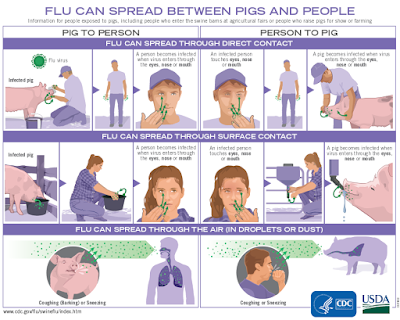#13,460
For the second week running the CDC is reporting 4 new novel H1N2v infections, all of which appear to be linked to attendance of county and state fairs. Three of the four report exposure to swine, while one did not.
Somewhat unusually, it has been the least commonly reported swine variant virus over the past dozen years - H1N2v - which has accounted for 8 of the 9 documented swine variant infections this year.First the announcement from today's FluView, then I'll return with a bit more.
Novel Influenza A Virus:
An additional four human infections with novel influenza A viruses were reported by three states (California [2], Michigan [1], and Ohio [1]). All four persons were infected with an influenza A(H1N2) variant (A(H1N2)v) virus. Three patients reported exposure to swine at an agricultural fair during the week preceding illness onset, while one patient attended an agricultural fair but no contact with swine was reported.
Three of the patients were children < 18 years of age and one patient was an adult < 25 years of age. No patients were hospitalized and all are recovering or have fully recovered from their illness. No human-to-human transmission has been identified.
A total of nine variant viruses have been reported to CDC during 2018. One of these has been an influenza A(H3N2) variant (A(H3N2)v) virus (Indiana [1]) and eight have been A(H1N2)v viruses (California [4], Michigan [3], and Ohio [1]).
Early identification and investigation of human infections with novel influenza A viruses are critical so that the risk of infection can be more fully understood and appropriate public health measures can be taken. Additional information on influenza in swine, variant influenza infection in humans, and strategies to interact safely with swine can be found at http://www.cdc.gov/flu/swineflu/index.htm.
Additional information regarding human infections with novel influenza A viruses can be found at http://gis.cdc.gov/grasp/fluview/Novel_Influenza.htm
While most of the reported swine variant infections over the past decade have been mild-to-moderate in severity, some people have required hospitalization, and deaths - while rare - have occurred (see J. Virology: Analysis Of A Swine Variant H1N1 Virus Associated With A Fatal Outcome).
Several weeks ago the CDC released a new infographic on preventing the spread of these viruses.
 | |||||
| https://www.cdc.gov/flu/pdf/swineflu/transmission-between-pigs-people.pdf |
The CDC's recommendations for people at a higher risk of influenza complications is to avoid pigs and swine barns altogether.
If you are at high risk of serious flu complications and are going to a fair where pigs will be present, avoid pigs and swine barns at the fair. This includes children younger than 5 years, people 65 years and older, pregnant women, and people with certain long-term health conditions (like asthma, diabetes, heart disease, weakened immune systems, and neurological or neurodevelopmental conditions).A week ago, the CDC - in conjunction with the USDA and 4H - released an ambitious 60-page graphic novel on swine variant flu and how disease detectives investigate outbreaks.
Today, the CDC is releasing new educational materials to go along with this graphic novel.
CDC Releases Educational Materials for Teachers for Use with "Junior Disease Detectives: Operation Outbreak" Graphic Novel
Language:
English (US)
Español
(SNIP)
The Junior Disease Detectives graphic novel and associated educational content is available at graphic novel
August 17, 2018 ̶ Today, the Centers for Disease Control and Prevention (CDC) released new educational materials for use in kindergarten through grade 12 (K-12) classrooms across the country in association with the CDC’s new graphic novel, “The Junior Disease Detectives: Operation Outbreak.” The graphic novel is intended to raise youth awareness of variant flu, which is caused by a kind of flu virus that spreads from pigs to people[1.2 MB, 2 pages], and to educate children and teens about careers in public health and outbreak investigations. The release of these new education materials today coincides with the report of four new variant virus infections in three states.
Variant virus infections also have the potential to cause flu pandemics, should these viruses gain the ability to spread easily between people. In 2009, a flu virus that had avian, swine and human genes emerged with the ability to spread easily among people, causing the 2009 H1N1 pandemic. Human infections primarily occur from exposure to infected pigs, as opposed to from person to person, but public and animal health officials investigate outbreaks of variant flu to ensure these viruses have not obtained the ability to spread easily between people and cause a pandemic. This year, nine variant virus infections have been reported in the United States, all attended agricultural fairs where swine were present, and most occurred in children.(Continue . . . )
We regularly cover swine and swine variant influenza in this blog, both in North America and around the world. For some recent blogs - in just the past 90 days - on its pandemic potential, you may wish to revisit:
BMC Vet.: Novel Reassortant H1N2 & H3N2 Swine Influenza A Viruses - Chile
J. Virology: Pathogenesis & Transmission of H3N2v Viruses Isolated in the United States, 2011-2016
JVI: Divergent Human Origin influenza Viruses Detected In Australian Swine Populations
The `Other' Novel Flu Threat We'll Be Watching This Summer
Emerg. Infect. & Microbes: Novel Triple-Reassortant influenza Viruses In Pigs, Guangxi, China

